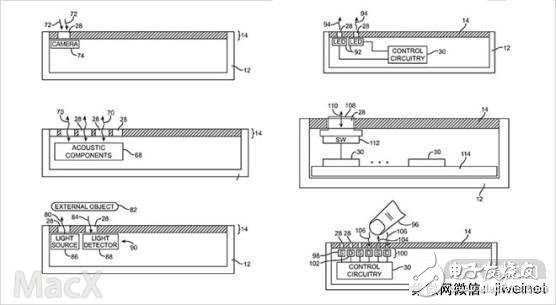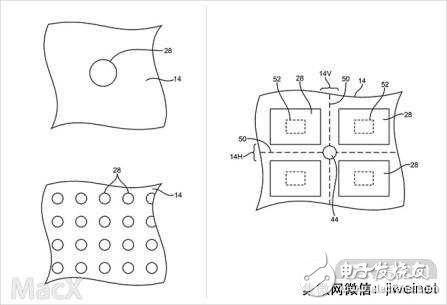Apple today approved a new patent related to the iPhone, which allows the handset, camera and head-up display to be hidden under the edge-to-edge screen. This design is likely to be released in the second half of the year. The next generation on the iPhone.

U.S. Patent No. 5,543,364 issued to the U.S. Patent No. 5,543,364, entitled "Electronic Device with Opened Screen", encompasses a method by which a small hole is made in the screen of the device, and It is difficult to distinguish with the naked eye. This allows engineers to design a phone or tablet to achieve a true edge-to-edge screen or a "full" display.
Until now, the aesthetic design of smartphones has been defined and limited by their main function, the front screen. The traditional candy bar design led by the iPhone puts the screen in the front and the middle, and other supporting hardware is arranged around.
For example, the iPhone is equipped with a central screen, and the "forehead" and "chin" are all equipped with sensors and physical buttons. Certain components, such as front camera, light sensor, and distance sensor, can be hidden under a fast cover glass or placed in an inactive portion of the screen. Others like the handset and home button need to be unobstructed to be accessed by the user, especially the Touch ID, meaning that these components cut some space on the front panel.
As smartphones become more compact, there has been a push to try to hide the basic components beneath the active (or light-emitting) area of ​​the screen. However, like most of the ideas of high technology, implementing such a system is easier said than done.

In its patent, Apple recommends that sensors and other devices be mounted under a series of openings or through holes in the active portion of the OLED panel. These openings may be left blank or, if desired, filled with glass, polymer, penetrable ceramic or other materials.
Positioning the sensor directly in line with the above opening contributes to the accumulation of light, radio waves, acoustic signals, and the like. Microphones, cameras, antennas, light sensors, and other devices will have unhindered access across the display layer, although the exterior is occluded.
Openings are formed between the pixels, which indicates that a self-luminous display technology such as an OLED is superior to a conventional LCD structure requiring a backlight and a filter layer. Depending on the application, the set of holes can be arranged in a variety of shapes and can be larger or smaller than the components below. For example, the opening for the camera can be circular and only as large as the objective lens, while the sensor module is orders of magnitude larger.

Or it may be that the opening itself has a varying shape and size allowing the auxiliary display to be mounted.
Interestingly, Apple mentioned that the patented technology can be used in built-in head-up display systems. In some embodiments, a window is created by providing one or more transparent regions at the front and rear of the device, in which a transparent OLED display is embedded. As the user's line of sight passes through these windows, they see digital images that are overlaid in the real world.
If implemented on a future iPhone, the window-based head-up screen HUD can be Apple's first augmented reality application. Apple does not mention specific mechanisms, but this system can theoretically transcend augmented reality and mixed reality.
For example, a rear camera can collect scene information and then process the scene information using local or cloud-based computer vision assets. A digital image containing useful information about the user can then be projected onto a real world object that is aligned with the sub-display.

Whether Apple will adopt this technology on future iPhones is not known, but it is reported that Apple will release a full-screen special version of smartphones later this year. As for Apple's patented HUD part, it is rumored that Apple is actively preparing to enter the AR market in the next one to two years, but not by a separate device.
Light Emitting Diodes Membrane Switch
membrane switches with LED provide Clear marking even in low light conditions. The control of the LEDs is very simple..
User-friendliness is the top priority for equipment operation. It must be easy to recognize and feel, and the lettering must be clear. In the dark? For example, in a hospital room at night, Or in tunnel construction for the neat.the demands on user-friendliness during the day and at night are as different. But these demanding requirements can be combined - thanks to membrane switches with LED lighting from Soushine.
Light Emitting Diodes Membrane Switch,Transparent Window Membrane Switch,Screen Printing Membrane Switch,Printing Machine Membrane Switch
Dongguan Nanhuang Industry Co., Ltd , https://www.soushine-nanhuang.com